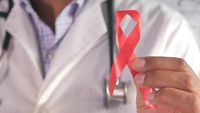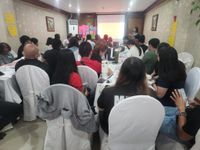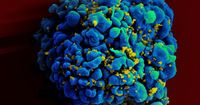Explore web search results related to this domain and discover relevant information.

As for advocates, progress, they expressed, will depend on the media’s willingness to shift from stigma to solutions.
CAGAYAN DE ORO CITY — In a bid to end the stigma surrounding the human immunodeficiency virus (HIV), advocates are calling on news professionals to drop fear-driven narratives and embrace fact-based HIV reporting during the “Visibility is Key” media dialogue on Friday.Stella Flores of the Pilipinas Shell Foundation stressed that while HIV is still wrongly labeled as a “gay disease,” she emphasized that anyone can acquire it. ... Transmission, she explained, can occur only through unprotected penetrative sex, infected blood or blood products, and mother-to-child transmission — not through hugging, sharing utensils, or casual contact. With these, Flores hopes that the media move forward through accurate coverage, expanding treatment access, and integrating comprehensive HIV care into communities.“The virus is indeed spreading, but so are the misconceptions,” said Malou Quintos, advisor for community support at Joint United Nations Programme for HIV/AIDS or UNAIDS. ... While media reporting has improved through the years, Quintos said they continue to read harmful terms like “AIDS victim,” “homosexual disease,” and even frame it as a punishment, Quintos added in mixed Filipino and English.For accurate reporting, journalists are encouraged to use available tools such as the media guide on HIV reporting, “Empowering Stories.”

Under Russian law, people living with HIV, tuberculosis, or hepatitis C should be exempt from military service. Yet, since the start of Russia's full-scale invasion of Ukraine, independent Russian media have reported that HIV-positive individuals continue to receive draft notices, either because ...
Under Russian law, people living with HIV, tuberculosis, or hepatitis C should be exempt from military service. Yet, since the start of Russia's full-scale invasion of Ukraine, independent Russian media have reported that HIV-positive individuals continue to receive draft notices, either because military officials are unaware of their health status or because they simply don’t care.The number of HIV and hepatitis cases among Russian soldiers is on the rise, as Moscow appears to be deliberately recruiting those sick — even encouraging their enlistment. According to the report from Carnegie Politika, the number of HIV cases detected in the Russian armed forces increased 13 times by the end of 2022, and was 20 higher by the end of 2023, compared to the start of the all-out war.Russia has recruited at least 250,000 prisoners over three years of the all-out war, according to Romanova's conservative estimate, with 40% suffering from serious illnesses like HIV, tuberculosis, or hepatitis.Several posts mention that the army is ready to take in people with "Umbrella," which appears to be a code word for recruits with life-threatening illnesses. The name derives from a Wagner Group unit that recruited people with HIV, hepatitis, or syphilis.
Initial events and trends in the discussion of HIV and AIDS in mass media contributed to the stigma and discrimination against those affected with the disease. Later discussion, sometimes led by HIV+ individuals themselves, moved toward advocacy and education on disease prevention and management.
Most media outlets have shown the tendency to universalize by emphasizing the risk to an entire age group, sex or sexual orientation as opposed to the behaviors and characteristics of individuals which pose the greater risk. How and when various media outlets throughout the world published this information varies, as has subsequent and contemporary reporting and depiction of HIV and AIDS in the media.Many artists and AIDS activists such as Larry Kramer, Diamanda Galás and Rosa von Praunheim campaign for AIDS education and the rights of those affected. These artists worked with various media formats. Worldwide and historically, public figures have often led trends in reporting HIV/AIDS issues.In media with a theme of the "other" there is some depiction of a dichotomy. The divide in stories depicting AIDS is often HIV-positive people versus people without HIV, persons at high risk for contracting HIV versus people with low risk, innocent victims of HIV versus people shown to have guilt, and the general concept of contamination in blood versus pure blood.In such themes, persons with HIV often threaten the health of innocent people. The United States news media associated AIDS with gay men beginning in 1982 despite the CDC at that time having regularly revealed that other populations also were contracting the infection causing AIDS.
Global situation and trends: Since the beginning of the epidemic, 91.4 million [73.4–116.4 million] people have been infected with the HIV virus and about 44.1 million [37.6–53.4 million] people have died from HIV-related causes. Globally, 40.8 million [37.0–45.6 million] people were ...
© WHO / Blink Media - Nikolay Doychinov · Global situation and trends: Since the beginning of the epidemic, 91.4 million [73.4–116.4 million] people have been infected with the HIV virus and about 44.1 million [37.6–53.4 million] people have died from HIV-related causes.Global situation and trends: Since the beginning of the epidemic, 91.4 million [73.4–116.4 million] people have been infected with the HIV virus and about 44.1 million [37.6–53.4 million] people have died from HIV-related causes. Globally, 40.8 million [37.0–45.6 million] people were living with HIV at the end of 2024.The WHO Department of Global HIV, Hepatitis and Sexually Transmitted Infections Programmes leads the development and implementation of the global health sector strategy on the elimination of HIV as a public health threat.An estimated 0.7% [0.6-0.8%] of adults aged 15–49 years worldwide are living with HIV, although the burden of the epidemic continues to vary considerably between countries and regions.
KFF is the independent source for health policy research, polling, and journalism. Our mission is to serve as a nonpartisan source of information for policymakers, the media, the health policy community, and the public.

Infodemiology and Infoveillance (1511) Medicine 2.0: Social Media, Open, Participatory, Collaborative Medicine (1857) Public (e)Health, Digital Epidemiology and Public Health Informatics (944) HIV/AIDS/STI Prevention and Care (998) Natural Language Processing (861) Machine Learning (1936) ...
Infodemiology and Infoveillance (1511) Medicine 2.0: Social Media, Open, Participatory, Collaborative Medicine (1857) Public (e)Health, Digital Epidemiology and Public Health Informatics (944) HIV/AIDS/STI Prevention and Care (998) Natural Language Processing (861) Machine Learning (1936) Infoveillance and Social Listening (288) Artificial Intelligence, Machine Learning, and Natural Language Processing for Public Health (75) Behavioral Surveillance for Population and Public Health Informatics (55)Background: HIV remains a global challenge, with stigma, financial constraints, and psychosocial barriers preventing people living with HIV from accessing health care services, driving them to seek information and support on social media.Objective: This study aims to (1) observe the dominant themes in current HIV-related social media discourse, (2) explore similarities and differences between theory-driven (eg, literature-informed predetermined categories) and data-driven themes (eg, unsupervised Latent Dirichlet Allocation [LDA] without previous categorization), and (3) examine how emotional responses and temporal patterns influence the dissemination of HIV-related content.Conclusions: HIV-related social media discourse on X reflects the dominance of informational content, the emergence of prevention as a distinct thematic focus, and the varying effectiveness of different timing patterns in HIV-related messaging.
These guidelines are intended to assist reporters, journalists, and the media in creating fair and ethical stories about people living with HIV and HIV policy, prevention, and treatment. It is critical that the media uphold the highest standards for fair and ethical journalism when covering HIV.
Reporters covering HIV and related topics have a duty to the public to fully understand the current landscape and accurately cover it. Public awareness and education are important factors in reducing the transmission of HIV and shaping public policy. Studies show that media coverage of HIV often contributes to increased stigma.No story is complete without the perspectives of those who are most directly impacted. Bear in mind that this is a diverse group, and that media representations of people living with HIV shape public perception.Studies have shown that racial and other disparities in HIV are not based on behavior but instead are rooted in economic barriers, lack of access to health care, and bias and discrimination by healthcare providers. Media coverage of the disparate impacts of HIV on specific communities can sometimes have the unintended effect of reinforcing negative stereotypes or perpetuating stigma.In the United States, 1.2 million people are living with HIV, and one in eight do not know their status. In 2022, more than 38,000 people received an HIV diagnosis. LGBTQ+ men, Black people, trans women, and people in the South are disproportionately affected.

Adolescents and young adults say they want to learn about HIV prevention the same way they learn about new tunes, life hacks, and the latest slang—on social media, according to a new study led by physician-scientists at Beth Israel Deaconess Medical Center (BIDMC) and Boston Children's Hospital.
To end the HIV epidemic, we need educational strategies specifically tailored to their developmental stage." To explore how best to bridge that knowledge gap, Krakower and colleagues—including corresponding author Carly E. Guss, MD, MPH, an attending physician in the Division of Adolescent/Young Adult Medicine at Boston Children's Hospital—created two short social-media-style videos: one with gain-framed messaging, which focused on the benefits of taking PrEP, and one with loss-framed messaging, which emphasized the risks of not using it.The findings suggest that public health campaigns aiming to reach youth should combine social media distribution with in-clinic viewing, use positive framing, and involve young people in content development. The study's authors say the findings can guide public health professionals looking to reach young audiences with HIV prevention messages.TikTok:" Applying behavioral economics to adolescent and young adult HIV pre-exposure prophylaxis education, Patient Education and Counseling (2025). DOI: 10.1016/j.pec.2025.109277 ... Citation: Social media videos could boost HIV prevention among teens and young adults (2025, August 19) retrieved 30 August 2025 from https://medicalxpress.com/news/2025-08-social-media-videos-boost-hiv.htmlShort, positively framed social media videos are effective in increasing interest and knowledge about HIV pre-exposure prophylaxis (PrEP) among adolescents and young adults. Participants preferred authentic, relatable content and indicated greater trust when videos were shown in clinical settings.

In Zambia, we met people who are HIV positive, couldn't get drugs to suppress the virus after U.S. aid cuts and were seeing symptoms. We checked in on them — and the man who's been their champion.
Pastor Billiance Chondwe has known 9-year-old Diana Lungu since she was born. He helped her mother through a rough pregnancy and during Diana's early years. Diana's mother died of AIDS when Diana was nearing her third birthday. Diana herself was born HIV positive.So, on January 24, when Secretary of State Marco Rubio issued a memo calling for stop work orders on all existing foreign aid awards, Chondwe watched in horror as many of the U.S.-funded HIV clinics in and around Kitwe suddenly locked their doors.All the HIV positive people profiled had something in common: They had received medical care from U.S.-funded clinics that were now shut, and they could not find another medical provider. Some had been turned away from other clinics because they weren't able to obtain their medical records from the closed clinics.Perhaps, he says, that's because some other U.S.-funded HIV clinics in Zambia, including in the capital, had been able to reopen shortly after the stop work orders with waivers Rubio issued that allowed them to resume limited services, like dispensing HIV medication.
For many people, the media is a main source of information about diseases. Learn how the media has influenced people’s understanding of HIV and AIDS.
According to the United Nations, over 50 percent of men and women report discriminating against people living with HIV. These stigmas develop from misinformation and misunderstanding about the virus. Since the start of the AIDS epidemic, the media has played a role in shaping the public’s perception.Several celebrities also became spokespeople for HIV and AIDS. Their public support, along with their roles in television and film, helped create more empathy. Learn what media moments helped audiences gain an empathetic and more understanding perspective.Since the emergence of the HIV/AIDS epidemic, research has shown that media coverage has reduced the stigma of the condition and cleared up some misinformation. Roughly 6 in 10 Americans get their HIV and AIDS information from the media.Karim SSA. (2014). New advances in HIVresearch and development. http://www.unaids.org/en/resources/presscentre/featurestories/2014/march/20140310salim · The media and HIV/AIDS: Making adifference.


Lawyer Angelica Gemelo of IDEALS discusses the Tisya Justicia online legal aid platform during the “Visibility is Key” Media Dialogue on HIV and AIDS in Cagayan de Oro City, highlighting how communities can access legal remedies for stigma, discrimination, and rights violations on August 15.
CAGAYAN DE ORO CITY (PIA)—In support of efforts to reduce new HIV (human immunodeficiency virus) infections and address stigma through accurate reporting and public education, the Department of Health (DOH), in coordination with media and community organizations, held a “Visibility is Key” media dialogue on HIV and AIDS (acquired immunodeficiency syndrome) on Aug.Maria Lourdes Quintos, UNAIDS advisor for community-led response, said stigma remains a major issue in the HIV response. Maria Lourdes Quintos, UNAIDS Advisor for Community-led Response, emphasizes the critical role of media in addressing HIV-related stigma during the “Visibility is Key” Media Dialogue on HIV and AIDS on August 15, held at Pearlmont Hotel, Cagayan de Oro City.The DOH also highlighted its ongoing work with civil society and legal aid groups, including IDEALS’ CARE Program, which assists individuals living with HIV and other vulnerable groups. Obsioma said the “Visibility is Key” initiative is part of the department’s broader effort to collaborate with media and communities to normalize conversations about HIV, promote early testing, and ensure responses are inclusive and grounded in human rights.“Many cannot access HIV services for various reasons. But there are also those who can access services but will not because of fears of being judged, stigmatized, and discriminated against,” she said. Quintos added that the challenge in the Philippines extends beyond the virus itself, as misinformation continues to spread. From the media sector, participants emphasized the importance of information-sharing events.

However, searches of Bing, DuckDuckGo, Google and Yahoo found no news media outlets reporting about criminals using syringes to inject HIV-infected blood into toilet paper. Similar searches also located no outlets publishing information similar to the headline appearing in Newsinforium's video ...
However, searches of Bing, DuckDuckGo, Google and Yahoo found no news media outlets reporting about criminals using syringes to inject HIV-infected blood into toilet paper. Similar searches also located no outlets publishing information similar to the headline appearing in Newsinforium's video posts.Searches for further posts about the toilet paper contamination rumor found a TikTok video claiming, "Two ladies have been spotted in London going around public toilets and injecting HIV into toilet paper." The clip also said "thousands of people have been infected" — a massive crisis that major outlets would have reported, if true. That TikTok account's page also displayed many other false or unfounded rumors. The AI-generated voice narrator in the videos promoting the toilet paper contamination rumor instructed users to share the clips with their own social media networks, saying, "If you don't share it, you will be complicit in the next victim.Users shared the rumor in September 2025 with the words, "Public Restroom Alert: Toilet Paper Contamination Sparks Health Concerns Across U.S."Searches for more information about the possibility of spreading HIV via toilet paper found a Forbes article discussing the history of the rumor and casting doubt on the idea that the virus could spread in such a way.
Get access to the latest ViiV Healthcare's press releases, company statements, and the main conferences and events about HIV/AIDS.
We are the only pharmaceutical company solely focused on curing HIV and AIDS, but of course, none of what we do can be achieved alone – we believe in the power of partnership. ... Our Media centre contains a range of resources including our latest and archived press releases and news updates, conferences and events we attend, our image and video library and social media information.These press releases and news updates are intended for media and investors only. We are excited to present new data from our innovative HIV treatment and prevention portfolio at one of the world’s most influential HIV meetings, the European AIDS Clinical Society Conference (EACS), in Paris, France.Whilst we continue to find new ways to treat, prevent, and ultimately find a cure for HIV, we are also focusing on understanding how we can bridge the gap between research and everyday clinical practice through implementation science and patient centred studies.We are ViiV Healthcare: 100% dedicated to HIV medicines and research and completely focused on people affected by HIV and AIDS.
Get tips on the best ways to use social media in advocacy around HIV/AIDS.
Together, we can change the course of the HIV epidemic…one woman at a time. ... Social media has changed the way people interact and how they get information around the world.These days most people get their information from social media (Facebook, TikTok, Instagram, X (formerly Twitter), LinkedIn, etc.), mainstream or "traditional" media (television, newspapers, magazines, radio), or a combination of both. Using your own social media, or communicating through mainstream media, can be great ways to inform the public about the issues, concerns, and day-to-day realities of living with HIV.Recent very public cases have made many more people aware of, and angry about, how much digital information (data) social media sites like Facebook collect – and even sell to other companies – from people who use their services. It is also a good idea to be prepared for Internet "trolls" (those who purposefully post mean and hateful comments). ... The Well Project program manager Ciarra "Ci Ci" Covin (@ci.ciiiiii) makes funny, touching, informative Instagram posts about life with HIV.We live in an age of "fake news" and "alternative facts," especially when it comes to health topics like HIV. Misinformation and disinformation can be detrimental to your cause, and confusing to your audience. It is fine to post based on your opinions, but when the conversation turns to facts, be sure to share accurate, evidence-based information from trusted sources so as not to contribute to these dangerous trends. We asked A Girl Like Me blogger and social media activist Maria Mejia to give her views and tips on using social media for raising HIV awareness.


Engaging with organizations focused ... by HIV could significantly enhance the conversation. His participation could catalyze discussions and encourage young individuals to take charge of their health. Celebrity influence is a powerful tool in shaping public opinion and behavior. When icons like Sean Combs speak out about health issues, they can reach audiences that might not otherwise engage with these topics. Through social media, interviews, ...
Engaging with organizations focused on health education and support for those affected by HIV could significantly enhance the conversation. His participation could catalyze discussions and encourage young individuals to take charge of their health. Celebrity influence is a powerful tool in shaping public opinion and behavior. When icons like Sean Combs speak out about health issues, they can reach audiences that might not otherwise engage with these topics. Through social media, interviews, and public appearances, celebrities can:Collaborate with HIV advocacy organizations to create impactful campaigns. Share information about testing and treatment options through social media.Misinformation: There’s a lot of misinformation surrounding HIV that can complicate advocacy efforts. Public Perception: The way the media portrays HIV can impact how celebrities choose to engage with the topic.In the world of music and entertainment, few names resonate as strongly as Sean Combs. Known for his multifaceted career as a rapper, producer, and entrepreneur, he has not only made waves in the industry but also generated conversations surrounding various critical health issues, including HIV.
Get updates on HIV-related blogs, news, and newsletters/e-news publications.
Get updates on HIV-related blog publications.Access news from HIV-related organizations.Access newsletters from HIV-related organizations.

TikTok, sebagai salah satu platform media sosial paling populer di dunia, telah mengubah cara manusia mengonsumsi konten. Video singkat, musik yang catchy, serta tren hiburan yang silih berganti membuat orang betah berlama-lama scrolling. Namun, di balik lautan hiburan yang menawan, ada satu persoalan serius yang justru semakin tenggelam: edukasi tentang HIV...
Di era digital saat ini, informasi mengalir begitu...Tidak berhubungan seksual sebelum menikah. Menunda aktivitas seksual sampai tiba waktunya pernikahan adalah bentuk proteksi diri paling aman. Bukan hanya dari HIV, tetapi juga dari berbagai infeksi menular seksual lainnya.Fenomena ini bukan sekadar soal minat generasi muda pada hiburan, tetapi juga tentang bagaimana informasi penting mengenai kesehatan, termasuk HIV, sulit menembus perhatian mereka.Padahal, di Indonesia kasus HIV masih terus bertambah setiap tahunnya, dan sebagian besar penderitanya justru berasal dari kelompok usia produktif remaja hingga dewasa muda.
HIV and STI visuals for your news media organization: public domain videos, graphics, and illustrations.
National Center for HIV, Viral Hepatitis, STD, and Tuberculosis Prevention | HIV | Viral Hepatitis | Sexually Transmitted Infections (STIs) | Tuberculosis (TB) ... Recent visuals for news media reporting on HIV and sexually transmitted infections (STIs).Access recent press releases about HIV and STIs.News releases and resources on HIV, Viral Hepatitis, STD, and Tuberculosis topics.

Looking for content to promote community conversations about HIV and sexual health? We’ve got you covered! This edition of our Let’s Stop HIV Together social media toolkit contains ready-to-go messages for posting on Instagram, Facebook, and X (formerly Twitter).
Ben shares the importance of talking openly and honestly with sex partners about HIV prevention.English translation: It starts with a conversation. Talk openly about HIV with your friends and loved ones to take control of your sexual health, show your support, and stay informed.Taking about sex and #HIV prevention doesn’t have to be hard.The words we use when talking about HIV matter.

At the International AIDS Society meeting this year, a young woman from South Africa spoke. She is the first Black woman from Africa to be potentially cured of HIV.
In July 2024, we published a story with the headline: "One of the 7 people cured of HIV tells his story. Can his cure work for others." This summer, at the International AIDS Society conference, came news of an exciting new development in the the ongoing effort to bring the epidemic to an end.FRESH (Females Rising through Education, Support and Health) which had begun in Umlazi back in 2012. Six years after Anele's diagnosis, this program would see her enrolled in the first-ever clinical trial to attempt to cure HIV patients in Africa.July 2025 article in the medical journal The Lancet, 10 people worldwide are considered cured of HIV after receiving stem cell transplants to treat aggressive blood cancer, which happened to destroy the virus. But that method is not considered safe or scalable.Biological responses to HIV differ between men and women, influenced by sex hormones. Yet, said Krista Dong, assistant professor at the Ragon Instute of Mass General Brigham, MIT and Harvard and FRESH's clinical director, women are vastly underrepresented in HIV cure research.


